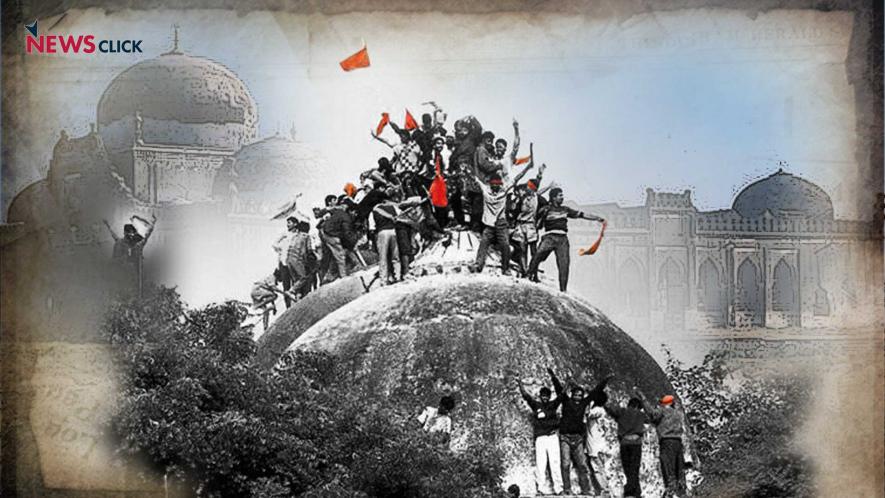Ramjanmabhoomi Case: Line Between Reason and Faith

The day-to-day hearings of the Ayodhya case in the Supreme Court fill one with forebodings. Already, people on the side of the one of the parties in the dispute are in a triumphalist mood waiting for the day of celebration while mute supporters of the other are downcast with sombre apprehension. Its outcome is going to decide the future of the nation and the culture it will be known by. Further, it will have an incalculable influence on the shape our democracy.
But the quotidian character of the trial, with counsels trotting out evidence that might be laughed out of court elsewhere, and their Lordships interjecting comments that would seem to vindicate such reasoning, leaves a general impression of a surreal inconsequence.
The moot point here is: where is the line between faith and reason in this bizarre trial? Law is not only a chain of legal reasoning, but its inherent rationality demands that extra-rational sanctions are not granted. Here, however, we meet pleas and demands not only to impute divinely juristic personality to an idol of uncertain origin, but even to ascribe juristic personhood to a holy place. Land laws that belong to the common core of our legal system are being overshadowed by faith-based claims.
Reason requires that tangible proofs are produced of sufficient volume and weight and are drawn upon to arrive at reasonable conclusions. The methods for drawing such conclusions are also universal and implicitly acceptable. But faith has on offer grounds like miracles and myths. Now, miracles defy common sense and seek to gag reason, while myth depends on magical analogies and associations that are the basis of all the superstitions.
It is beyond our understanding how a trial that is teetering along a rather fine line between reason and faith can deliver a judgment that will not only settle a dispute of faith, but open the way to further court interventions in matters of faith under some pretext or the other. The two realms should be kept separate for the sake of sanity.
Also watch: History Can Never be Used to Justify Faith: Romila Thapar
In colonial times, police officers often stumbled upon land disputes involving the miraculous emergence of an idol of Shiva, Vishnu or some other deity in government Khas land and often credulous devotees would build a shrine around it. Witnesses would say that the deity emerged exactly at the spot a wandering mendicant predicted if water was poured on it for seven days to the chanting of mantra—which, they would claim, was done. Police officers then were not disarmed by the claims of faith. They would stubbornly seek to expose the fraud. It would usually turn out that the mendicant had dug a hole at the said spot, had placed a big bowl of gram with a god's image on the top and covered it with earth tamped down to erase signs of digging. After a week of getting soaked with water, the buried gram would burgeon and would increase in mass, pushing up the idol through the ground.
The idols of Ram, reason says, not in any way different from the terra cotta figures of Hindu deities at the village fairs, were in all probability surreptitiously introduced. That aspect was not considered at all. Instead, from the very beginning, an unquestionable divine authority has been claimed and it was not challenged at any stage. There are no photographs available from before that particular date. Instead, there are witnesses claiming to have seen it before that date. Can such a claim stand rational scrutiny?
Sometimes, science is used in our country to back superstitions like Council of Scientific and Industrial Research (CSIR) scientists producing to order 'scientific' nostrums out of cow-dung.
The idea in some circles that the alleged remains of a massive structure on the site from before Babri Masjid is on the basis of an Archaeological Survey of India (ASI) report is another example.
First, even scientific data are at times misinterpreted by scientists to suit their pet theories. A recent example is rejection by two reputed Indian scientists of a wide consensus of experts on genetic evidence of Aryan migration to India.
A few experts from ASI were already convinced of the presence of the Ram temple at the sight. Their inference was most probably guided not so much by the actual findings as by their bias. B B Lall, who did not originally propound this theory, later backed it without any further evidence. Other experts were not convinced.
Besides, supposing there was such a temple, where is the evidence that the Babri Masjid was built by demolishing it? Evidence has not proved that it came up at about the same period or soon after the temple. It might have been on ruins of an old temple. Such ruins were not unknown in ancient times. The Buddhist stupa at Sanchi was such a ruined structure for centuries. Ajanta had been abandoned for centuries. So, claim to ownership of the site is a later myth.
The writer is a well-known literary critic and social scientist based in Assam. The views are personal.
Also read: Ayodhya Case: SC Asks How Birthplace Can be Made Party to Land Dispute
Get the latest reports & analysis with people's perspective on Protests, movements & deep analytical videos, discussions of the current affairs in your Telegram app. Subscribe to NewsClick's Telegram channel & get Real-Time updates on stories, as they get published on our website.























